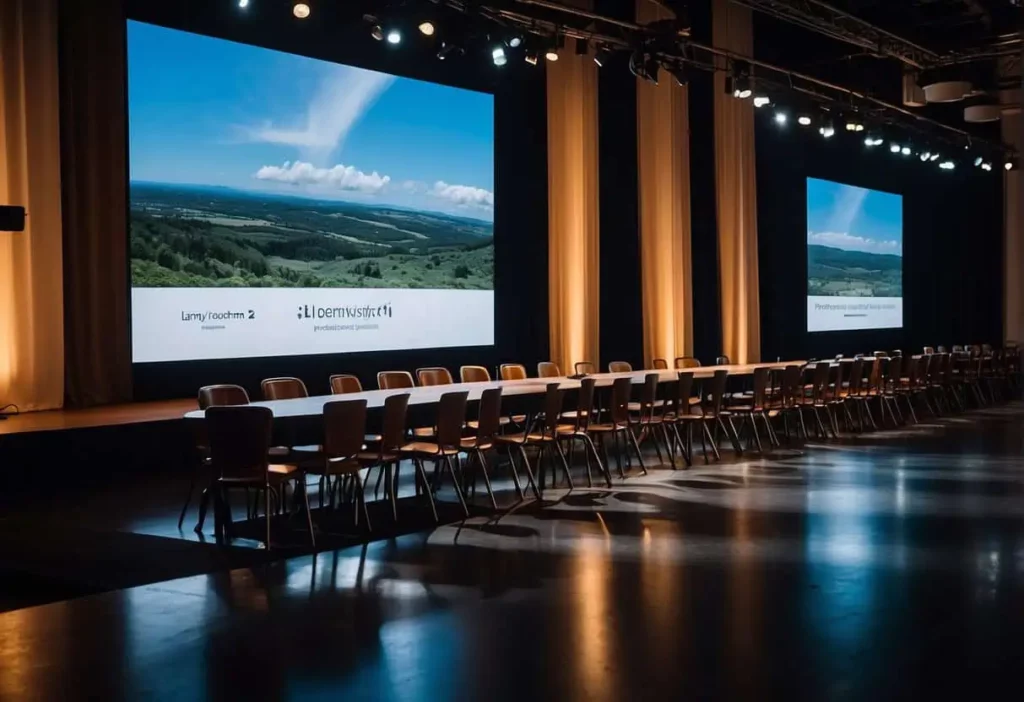Event planning is a multifaceted discipline that requires meticulous attention to detail and a clear understanding of the desired outcomes.
Whether for a corporate function, a social affair, or a community event, the key to a successful gathering is a solid blueprint that outlines every aspect of the event.
This begins with a clear definition of the event’s objectives and goals, which serve as the foundation for all subsequent decisions from the theme to the choice of venue and the design of promotional materials.
A well-thought-out event plan acts as a roadmap, guiding the planner through each phase of organizing the event.
It includes budgeting and financial management to ensure the event’s feasibility, selecting a venue that fits the event’s requirements, and creating an effective marketing strategy to attract attendees.
Furthermore, the plan includes details on team management, logistical arrangements, vendor coordination, and the execution of the event itself.
Post-event activities are also crucial as they allow for the assessment of the event’s success against its original objectives.
Key Takeaways
- Crafting an event plan requires a clear definition of the event’s goals and a strategic approach to achieve them.
- Effective event management includes careful budget oversight and selection of an appropriate venue.
- Execution and follow-up are essential for meeting objectives and enhancing the attendee experience.
Understanding Event Objectives and Goals
Event planning begins with a firm understanding of the event’s purpose and the establishment of clear, quantifiable objectives. This foundation is essential for guiding all subsequent planning decisions and measuring the event’s success.
Defining Purpose and Relevance
The purpose of an event directly influences its relevance to both the organizers and the attendees.
One must ensure that the event’s goals are aligned with the organization’s broader objectives.
For instance, a goal might be to increase brand awareness or to foster community engagement, both of which should support the overarching mission of the organization hosting the event.
Setting Measurable and Time-Bound Targets
Objectives should be specific, measurable, attainable, realistic, and time-bound (SMART).
This means each goal must have a clear metric for success and a deadline.
Whether it is selling a target number of tickets or raising a specific amount of funds, having a quantifiable aim allows for the tracking of progress and the evaluation of the event’s return on investment (ROI).
- Measurable: Targets have quantifiable metrics such as a 20% increase in ticket sales or a fundraising goal of $50,000.
- Time-Bound: Objectives include a specific timeline, such as achieving the set targets one month post-event.
Aligning with Organizational Vision
An event’s objectives must reflect and support the organization’s vision to ensure cohesion and long-term value.
When the event’s goals contribute towards strategic objectives, such as entering a new market or launching a product, they carry more significance and are more likely to garner internal and external support.
- Alignment Example:
- Event Goal: Engage with industry leaders to establish partnerships.
- Organizational Vision: To become a thought leader in the industry.

Formulating the Event Plan
When planning an event, detailing the event type, selecting the appropriate date, and creating a comprehensive timeline are critical steps in the event planning process.
Choosing the Specific Type of Event
The event type sets the foundation for all subsequent planning.
Whether it’s a conference, wedding, or a corporate retreat, the specifics of the type—such as audience, purpose, and scope—dictate the planning requirements.
Each type of event comes with its own set of needs; for instance, a fundraising gala demands different logistical considerations than a trade show.
The planner must ensure the event resonates with its intended audience and achieves its main objectives.
Determining Start and End Dates
Selecting the right date is about more than just finding a day that suits the primary stakeholders.
The planner should consider holidays, potential weather conditions, and industry events that might compete for the same audience.
Ideally, they should have multiple date options to increase the likelihood of venue availability and to accommodate any unforeseen scheduling conflicts.
The start and end dates will later anchor the planning timeline, influencing the deadlines for tasks like vendor bookings and event promotion.
Drafting a Detailed Timeline
A well-drafted timeline is the backbone of any event plan.
It itemizes every task, from initial concept to post-event follow-up, and assigns due dates for each.
This can include milestones like finalizing a budget, securing speakers or entertainers, and the set-up of the venue.
A robust timeline not only provides a roadmap for the event planner but also keeps the entire team aligned and accountable.
A table format can help to visualize the event planning steps effectively:
| Milestone | Deadline |
|---|---|
| Venue Booking | 6 months prior |
| Vendors Confirmation | 4 months prior |
| Marketing Campaign Launch | 3 months prior |
| Final Run-through | 1 week prior |
Budgeting and Financial Management
Efficient budgeting and financial management are foundational to the success of any event. They empower planners to allocate resources wisely, ensure financial sustainability, and measure the event’s fiscal performance.
Creating an Event Budget
The starting point for any successful event is a well-defined budget.
The event budget outlines all expected costs and incorporates forecasted revenue to ensure the event remains financially viable.
Planners begin by listing all potential expense categories, which typically include:
- Venue: Costs for renting event space.
- Catering: Food and beverage expenses.
- Decorations: Visual and thematic elements for the event setup.
- Entertainment: Fees for performers or speakers.
- Marketing: Promotion and advertising expenses.
- Technology: Costs for event management software or automated solutions.
Calculating Expected Revenue
Once expenses are estimated, planners must project the event’s revenue, which constitutes the financial backbone of the event.
Revenue can come from:
- Ticket Sales: Priced strategically to cover costs and generate profit.
- Sponsorships: Support from businesses in exchange for branding opportunities.
- Merchandise: Sales from event-themed products.
- Grants: Funds provided by government bodies or foundations for specific event types.
It’s critical that expected revenue is estimated as accurately as possible to avoid financial shortfalls.
Forecasting Expenses
Forecasting expenses involves an in-depth projection of costs associated with the event.
Planners evaluate both fixed and variable expenses to create a comprehensive overview.
Essential to this process is also the recognition and accommodation for unexpected costs, ensuring a contingency buffer is in place.
Expense forecasting assists with:
- Vendor Contract Analysis: Scrutinizing agreements for hidden costs or potential savings.
- Quantity Estimates: Calculating quantities needed for various items like catering to prevent waste.
- Price Research: Seeking quotations and comparing costs to ensure competitive pricing.

Selecting the Right Venue
When planning an event, selecting the right venue is crucial as it influences the event’s accessibility, atmosphere, and logistics. The venue should align with the event’s scale, vision, and technical requirements.
Assessing Location and Accessibility
Location: The venue’s city and specific location are paramount. They should not only resonate with the event’s purpose but also be conveniently situated for attendees.
Key aspects to assess include:
- Proximity to public transport and major highways.
- Ease of access for out-of-town guests, such as distance from airports or train stations.
Accessibility: A venue’s accessibility affects attendee experience and attendance rates. Consider:
- Adequate parking availability.
- Facilities for individuals with special needs.
Evaluating Rooms and Capacity
Rooms: Different events require different spaces. The rooms should offer a suitable backdrop and accommodate the event’s activities. Key considerations include:
- The style and decor that complement the event’s theme.
- The availability of multiple rooms if breakout sessions are necessary.
Capacity: Overcrowding or underutilization of space can dampen the event’s success. One must evaluate:
- The maximum capacity of the venue to ensure it can comfortably accommodate all attendees.
- Flexibility in room arrangements for different group sizes.
Considering Venue Logistics
Logistics: Effective coordination of event logistics is essential for smooth operations.
Factors to consider when reviewing venue logistics include:
- Availability of on-site technical support and equipment.
- Catering options and restrictions, if any.
Vendor Coordination: Often, events require collaboration with external vendors. The venue should be able to facilitate this by:
- Providing a list of preferred or exclusive vendors.
- Offering clear guidelines for vendor setup and delivery.
Designing Marketing and Promotional Strategies
Effective marketing and promotional strategies are vital to ensure the success of an event.
These strategies should encapsulate branding, comprehensive planning, and digital outreach to maximize attendance and engagement.
Building a Branding and Logo Strategy
A strong brand identity is crucial for an event. It starts with a well-designed logo that reflects the event’s theme and ethos.
The logo should be used consistently across all promotional materials, creating a visual identity that can be easily recognized.
- Consistency: Maintain color schemes and font choices across all platforms.
- Visibility: Feature the logo prominently on advertising materials, event merchandise, and digital channels.
Creating an Effective Marketing Plan
An effective marketing plan outlines the goals, target audiences, and the tactics to reach them.
It should detail:
- Objectives: What the event aims to achieve (e.g., ticket sales targets, brand awareness metrics).
- Audience Segmentation: Tailor strategies to different segments, ranging from industry professionals to general attendees.
- Tactics and Tools: Consider a mix of email marketing campaigns, content marketing initiatives, and targeted advertising.
Key Tactics:
- Email Marketing: Scheduled newsletters and promotions to a subscription list.
- Content Marketing: Educational and informative blog posts, speaker interviews, and video content.
- Advertising: Paid strategies across Google Ads, radio spots, and print media.
Implementing a Digital Promotion Plan
In the digital age, a savvy promotion plan is anchored in social media and online platforms. It includes:
- Social Media Mentions: Leverage hashtags, influencer partnerships, and live streaming sessions to increase visibility.
- Robust Online Presence: An event website and social media pages should be updated regularly with engaging content.
- Analytical Tools: Use data analytics to track engagement and adjust strategies in real time for the most impact.
Organizational Structure and Team Management
Organizational structure and efficient team management are fundamental to executing a successful event.
An optimal structure facilitates clear communication, delineates responsibilities, and ensures that every team member has a defined role contributing towards the event’s objectives.
Assembling Your Event Team
When constructing an event team, it’s crucial to identify diverse talents that collectively meet the event’s needs.
Teams often comprise individuals from various departments within the organization and may include volunteers and partners.
A balanced team will have both creative minds to conceive ideas and practical individuals to execute them. Consider the following structure:
- Event Manager: Leads and oversees the whole event.
- Marketing Coordinator: Manages promotional strategies.
- Logistics Coordinator: Ensures all materials and services are on schedule.
- Volunteer Coordinator: Recruits and manages volunteers.
- Administration: Handles paperwork and customer service.
Defining Team Roles and Responsibilities
Each member of the event team must understand their specific responsibilities. Clearly defined roles prevent task overlap and confusion. For instance:
- Event Manager: Strategizes the event from conception to completion.
- Marketing Coordinator: Develops campaigns and tracks engagement metrics.
- Logistics Coordinator: Coordinates with suppliers and venue managers.
- Volunteer Coordinator: Assigns tasks to volunteers and offers support.
- Administration: Processes bookings and answers attendee inquiries.
A detailed task list for each role ensures accountability and clarity.
Using Event Management Software
Event management software is a pivotal tool for team collaboration and organization. It allows for:
- Centralized communication among all team members.
- Task assignment and deadline tracking.
- Budget management and expenditure tracking.
- Attendee registration and feedback collection.
Such software can streamline operations, allowing team members to focus on delivering a memorable event experience rather than getting bogged down by manual coordination efforts.

Logistical Arrangements and Vendor Coordination
Effective event planning hinges on meticulous logistical arrangements and seamless vendor coordination.
Key to this process is ensuring that all moving parts, such as entertainment, catering, and tech provision, are synchronized to create a structured and successful event.
Scheduling Entertainment and Catering
When coordinating entertainment and catering, establishing a timeline is crucial. The event planner should:
- Confirm all entertainment acts by contracting them on definite dates and times.
- Schedule catering services, aligning their meal and snack timings with the overall event schedule.
For example, if live music is expected to perform, the event planner needs to arrange sound checks in addition to setting precise performance times. Correspondingly, catering needs to be ready to serve food hot and fresh, in a window that best suits the event’s flow.
Coordinating with Tech and A/V Providers
Tech and A/V providers are the backbone of many events. To ensure smooth operations, the planner should:
- Outline all technical needs, including microphones, projectors, or specific software.
- Set up schedules for equipment testing and troubleshooting with A/V technicians well in advance.
It is also important for the event planner to coordinate times for the setup and breakdown of all equipment, making sure it doesn’t clash with other scheduled activities.
Securing Transportation and Accommodations
Transportation and accommodations are often overlooked but are essential for events, especially those with out-of-town guests. The event planner is responsible for:
- Arranging transport to and from the venue for guests, if necessary.
- Blocking off hotel rooms or arranging group accommodations to ensure everyone has a place to stay.
Efficiency in these arrangements can significantly enhance the guest experience, and attention to detail, such as considering traffic patterns when scheduling transportation, can prevent unwanted delays.
Event Production and Execution
In event production and execution, attention to detail is critical.
Organizers must seamlessly manage registrations, ensure effective signage and decorations, and execute the event according to a well-planned schedule.
Managing Registrations
A successful event begins with efficient registration management.
Organizers should leverage technology to create a streamlined registration process, enabling attendees to sign up with ease. Using a reliable registration platform ensures accurate attendee counts and can provide valuable data for future events.
- Pre-registration: Offer early sign-ups with incentives.
- On-site registration: Ensure adequate staffing and tech support.
Setting Up Signage and Decorations
Strategic placement of signage guides attendees and enhances the event’s brand.
Signage should be clearly visible and reflect the event’s theme.
Decorations contribute to the atmosphere and can transform a venue, making the environment align with the event’s essence.
- Directional signage: Clearly mark areas like registration, restrooms, and emergency exits.
- Decorative elements: Use consistent color schemes and themes to maintain visual coherence.
Executing the Event Schedule
Executing an event requires precision and adherence to a predefined schedule.
Effective production entails ensuring that all elements, from speakers to entertainment, align with the timeline. Delays or changes should be communicated swiftly to all stakeholders.
- Timeline: Maintain a detailed schedule with time slots for each segment.
- Contingency planning: Prepare for unforeseen circumstances with backup options.
Engaging Attendees and Enhancing Experience
To create a memorable event, one must focus on facilitating meaningful interactions among attendees, incorporating engaging elements that resonate with diverse demographics, and adeptly managing the nuances of both in-person and virtual participation.
Facilitating Networking Opportunities
Networking is a cornerstone of the event experience, and organizers can provide structured environments for this with tools like speed networking sessions or matchmaking applications based on professional interests.
For virtual events, leveraging platforms with breakout rooms or virtual meeting spaces allows attendees to form connections as they would in an in-person event.
Incorporating Interactive Elements
Interactive elements inject excitement into the event and increase attendee engagement.
Introducing point-based games or social media competitions can invigorate participation.
For educational sessions, integrating real-time polling or live Q&As can keep attendees actively involved.
It is crucial these activities are tailored to the event’s demographics to ensure maximum relevance and appeal.
Managing In-Person and Virtual Participation
For hybrid events that cater to both in-person and virtual attendees, organizers must ensure consistent engagement across formats.
This can be done by offering simultaneous streaming services for virtual attendees and providing them with opportunities to interact with the in-person audience.
Attention should also be paid to remote participants’ time zones and technological access to make the event inclusive and equitable.
Partnerships and Sponsorship Management
Creating successful partnerships and securing sponsorships are critical to the success of any event, including conferences. They provide essential funding and can enhance the event’s reputation and reach.
Let’s explore the process of managing these crucial aspects.
Identifying Potential Sponsors and Partners
Firstly, event organizers must clearly understand their goals and the desired outcomes of their event.
They should then identify potential sponsors and partners that align with their event’s theme and values.
This involves researching the reputations and evaluating the compatibility of these entities to ensure a mutually beneficial relationship.
Organizers could consider creating a list that categorizes sponsors and partners based on their relevance and potential impact on the event.
- Prioritized List of Potential Sponsors and Partners:
- Tier 1: Highly relevant brands with significant industry influence.
- Tier 2: Up-and-coming brands with potential for growth.
- Tier 3: Local businesses interested in community engagement.
Negotiating Sponsorships and Roles
Effective negotiation involves clear communication of the benefits and responsibilities associated with the sponsorship.
Organizers should define the specific terms of the partnership, including financial commitments, roles, and expectations from both parties.
This could include exclusive branding rights or speaking opportunities for sponsors.
Contracts must be transparent and benefit all involved parties to foster trust and long-term collaboration.
- Key Components to Discuss and Agree Upon:
- Financial Commitment: Includes sponsorship levels and monetary or in-kind contributions.
- Roles and Responsibilities: Outlines the expectations and deliverables from each party.
- Benefits to Sponsors: Highlights the exposure, access to the audience, and other advantages for the sponsors.
Integrating Sponsors into Event Branding
Sponsors should be thoughtfully integrated into the event to add value without overshadowing the event itself.
This integration can be achieved through various marketing materials, social media announcements, and event signage that feature the sponsor’s branding.
Sponsors can also be included in programming, such as panels or workshops, which should align with the event’s content to maintain coherence and enhance the experience for attendees.
- Integration Strategies:
- Marketing Materials: Use sponsor logos and messages in promotional content.
- Event Experience: Include sponsored sessions or features that engage attendees.
- Visibility and Recognition: Ensure sponsors are acknowledged during the event.

Post-Event Activities
After an event, it’s crucial to gather data and insights to evaluate performance and inform future planning.
Focusing on a detailed post-event review, measuring success and ROI, and managing the publicity that follows are all key elements in leveraging an event’s momentum for continued success.
Conducting Post-Event Review
Immediately following an event, organizers should convene to discuss the outcomes against predetermined objectives.
Post-event review sessions must involve all stakeholders and cover various aspects from logistics to content delivery.
It’s vital to:
- Gather Feedback: Distribute surveys to attendees, vendors, and staff to collect comprehensive feedback.
- Analyze Metrics: Review registration data, attendance figures, and engagement levels.
Measuring Event Success and ROI
The success of an event is quantifiable through careful analysis of both qualitative and quantitative data.
Organizers should consider:
- Financial Performance: Compare the actual event expenditure against the budget and calculate the ROI by considering revenue generated through tickets, sponsors, and sales.
- Achievement of Objectives: Assess if the event met its goals, such as brand awareness, lead generation, or educational impact.
Managing Publicity and Social Media Aftermath
Post-event publicity shapes the public perception of an event. Teams should actively manage it by:
- Social Media Engagement: Share highlights and engage with attendees on platforms like Facebook, Twitter, and Instagram.
- Press Releases: Distribute a press release summarizing the event’s success, key takeaways, and potential future dates.
Frequently Asked Questions
When planning an event, attendees often have questions that need addressing. This section aims to cover some of the most common inquiries related to event planning.
What are the key components of an event planning checklist?
An event planning checklist should include venue selection, catering, entertainment, AV requirements, transportation, and a detailed timeline. Tracking these components ensures nothing vital is overlooked.
Can you outline a standard event planning process?
The standard event planning process begins with defining the event’s purpose and goals, followed by budgeting, scheduling, selecting venues, vendors, and talent, and concludes with executing the event and post-event analysis.
What factors should be considered when setting a budget for an event?
When setting a budget for an event, one should consider venue costs, catering, technology needs, marketing, decor, staff wages, insurance, and contingency funds for unexpected expenses.
How does one measure the success of an event?
Success can be measured through attendee satisfaction, achievement of event objectives, return on investment, social media engagement, and post-event feedback.
What strategies are crucial for effective event marketing?
Effective event marketing strategies include a strong online presence, social media campaigns, early bird and group discounts, influencer partnerships, and targeted email marketing campaigns.
How important is contingency planning in event management?
Contingency planning is vital in event management. It prepares organizers for unexpected circumstances such as weather disruptions, technical failures, or security issues.
It ensures the event can proceed smoothly despite challenges.

